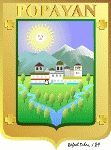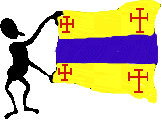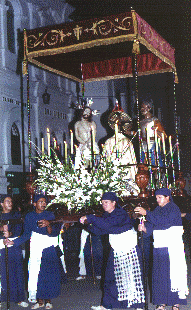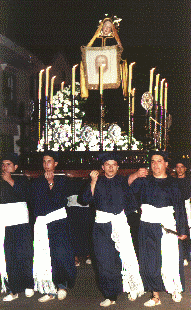Popayán (Colombia)
|
| Height:1.737
meters on the level of the sea. Temperature averages yearly: 19 C. Number
of inhabitants (1995): 223128 |
|
What
does it mean the name of Popayán?
There
are several versions, but the most diffused one is that of an old columnist
that said that the word POPAYAN is derived of some American autochthonous
dialect (the " guambía ") and that he/she breaks down this way:
po:dos pa: straw and yan: village, that is to say, two villages of straw.
Obviously, it is no longer any straw village in the current city.
The
coat of arms of the city 
For the
Real Identification given in Valladolid at 10 November of 1558,
Felipe II it grants to the city of Popayán in payment,as you demand
,that have and have for their well-known weapons a shield that is amid
him a city of gold, with some green groves to the round of her and two
rivers: the one one of a part of the this city and the other of the other
one, between green groves and blue and white waters; and in the high thing,to
the right hand, a snowy mountain and a sun above the this mountain, in
blue field a fringe with four crossings of red Jerusalem,in field of gold"
The
flag of Popayán 
You taking
of the same coat of arms and it is formed by two horizontal bands of color
gualda (yellow) divided by a color fringe azure (blue) and surmontadas
on each one of the yellow bands four crossings of Jerusalem will go. Its
meaning, according to the Heraldry is the one following: " the glory of
the high facts and of the ideal noblemen, decorated by the cross of the
sacrifice"
Surroundings
of Popayán
Toward
the North:
-)
High and low palacé, places where they had place battles for the
independence in 1811 and 1813
-)
Hacienda Calibío: Made in the second half of the XVII century. There
he/she took place the battle of Nariño against Sámano and
Asín in 1814.
-)
Church the Jimena, this way call in honor of the Bishop Salvador Jiménez
of Enciso who died when it was building it in 1841.
Toward
the West:
-)
Airport of Machángara, inaugurated in 1949. Airlines that you/they
lend the flight service to Popayán: Intercontinental and Avianca.
For via terrestrial, one can arrivar from Cali (136 Kms
of journey) in approximately 2 hours. State of the highway: Good.
-)
Towns of Puelenje, Cajete, and to the bottom it is sighted the hill of
the Nipple and the Western Mountain range in that he/she is the hill of
Munchique,
where the lecturer of the national TV is.
Toward
the South:
-
)Casa Caldas that fué of the Tenorios, grandparents of the wise
payanés Francisco José of Caldas and Tenorio.
-
)Casa Museo of the painting Efraim Martínez, author of the monumental
Apotheosis of Popayán that presides over the auditorium of the University
of the Cauca.
Toward
the East:
-)
Hill of Nativity, with their sanctuary of the Amo Ecce-Homo. To this you
ascends for a serpentine, paved road and framed by sculptural groups that
Christ's Viacrucis represents. This road is denominated The Quingos."
-)
Muzzle of Tulcán, where he/she is the statue of the founder of the
city, Don Sebastián of Belalcazar. Apparently, this geographical
prominence it is not natural but that was lifted by the
native of the region.
-)
Hill of the Three Cruzes, call also Hill of the M. Here is the antennas
for the reception of the TV via satellite whose sign arrives to
the whole city.
-)
To the bottom, on the Central Mountain range, the volcanos of the Puracé
and Sotará can be sighted.
Brief
history of the University of the Cauca
For ordinance
of April 24 of 1827, Paula Santander's general Francisco, in charge of
the executive power, made the Departmental University of the one Third
District, with base in law dictated by the Libertador Simón Bolívar.
It was founded following November 11, being their first rector effective
the priest Manuel José Mosquera. Don Manuel María Mallarino
was the first student in receiving lawyer's diploma in August 16 of 1828.
The
first studies were in philosophy, mathematics, jurisprudence and theology.
For 1835 those of Medicine began.
At
the moment the University of the Cauca has been erected as one of the main
institutions of Superior education in the Colombian Suroccidente, with
an extensive influence area and a variety of programs academics so much
professional as technological. They stand out mainly, those abilities of
Right, Medicine, Civil Engineering and Electronic Engineering, this last
one grateful at national and international level as one of the best for
the great quality of the offered formation.
For
further reports on the programs that offer, to go to the page of the Universidad:www.ucauca.edu.co
The
switch of the University of the Cauca is: (928) 243020
In
Popayán other institutions that technological programs and professionals
offer also exist:
Major
College, Tel: (928) 240562
University
foundation, Tel: (928) 238005
Cooperative
university, Tel: (928) 244501
University
Antonio nariño, Tel: (928) 244215
It
points out of the foundation of Asunción of Popayán.
Popayán,
capital of the department of the Cauca, it was founded January 13 1537
by Sebastián of Belalcázar and, to be in the one I walk among
Cartagena, to the north, and I Remove and Lima, to the south, played a
primordial part in times of the Colony.
As
result, Popayán is one of the most traditional cities in Colombia
and one of its main architectural jewels.
Although
great part of its colonial constructions was destroyed by an earthquake
in 1983, they have already been reconstructed in its bigger part.
The
Chapel of Nativity are among the places of interest, in a promontory with
a good panoramic view of the city, the Hermitage, San Francisco's temples,
of the Carmen, of the Incarnation, of San José and of Sacred Domingo,
and the convent
and
the church of San Agustín. The museum of religious art keeps colonial
objects of great value. Likewise, they can visit one another the House
Caldas, the Museo Martínez, the Casa Valencia, the Casa Negret and
the University of the Cauca. Other places of interest are the one Bridge
of the Humilladero, the Tower of the Clock, the Muzzle of Tulcán
and the Hotel Monasterio that it works in what was the old one Franciscan
monastery.
To
55 kilometers of Popayán, in a mountainous region of beautiful places,
Silvia, a typical town of houses is of it walls footfall and square of
traditional market. In the surrounding fields he/she inhabits the community
of indigenous Guambianos, a town of ingrained ancestral customs.
Another of the attractiveness of the region is he Natural National Park
of Puracé,
that
it occupies a surface of 83.000 hectares where lagoons are plentiful, cascades,
volcanos, snowy and thermal sources.
To
70 kilometers to the east is the inactive Volcán Puracé.
Week
Santa in Popayán
Brief
informative note
For the visitor that really
wants an experience that he/she teaches him the intensity to live with
that one lives the tradition in the town payanés, behind the static
seriousness of the temples and the images, there is not anything better
than attending the celebrated season of Week Santa in Popayán.
Suddenly, the whole unfolding
of religious art charges validity, the temples flourish, you embellecen
the images, unite the shoulders and the hearts, and the city finds out
he/she surrenders to the great coexistence, where all and each one renovates
their fé and their hope, at the same time that it strengthens their
happy tradition. It is, without a doubt, something unforgettable.
The Week Santa in Popayán
it is great unfolding religious's festivity, traditional as the one of
Seville in Spain, and equally noble in their presentation and splendid
in their details. Of the tradiciones payanesas, is the only one that has
resisted, it resists and it will resist the mercantilist push of those
new times and the unworried scepticism of the payanés always. Because
the Week Santa it is something that it is only in the blood españolísima
of our gentes,no as external manifestation of their faith it christens,
but as the vital spirit of the tradition that there is you inform the idealistic
soul of Popayán, and it emblazons it with the unfading page of their
clean catolicidad of fanaticisms and aristocratically harmless to the intolerance.
It culminates in this prodigious
manifestation of the external cult the Week Santa, when in the burned night
of liturgical candles, in the quiet oblación of tremulantes candles,
they parade for the streets, among the one disciplined asinamiento of the
devote multitudes, the Steps or Mysteries that you/they attest and they
evoke the one drama of the passion and death of Christ.
It is not this, like he/she
could think who has not still attended the imposing show, a procession
more among those that are used with identical reason. If this way the prestige
of these festivities would not have outside, surpassed the municipal horizon,
neither the praise of its magnificence would walk in the illustrious foreigners'
mouth and of the singular character that makes them only in America.
Who have been spectators
of those of Salamanca, Toledo, Córdoba, Granada and León,
in Spain, they are better qualified to prosecute the processions of Popayán.
And to many that have seen the peninsular ones, there are them heard to
affirm that those. with being exceptionally splendid, they don't lead ours
neither in order, neither in character, neither in dignity, although yes
in some details in ornamentation and liturgy survivors of the Age Half
Christian.
As much as to the wealth
of the images that you/they integrate the steps, we have them of first
order like the Christ of the Veracruz, the Ecce Homo of Nativity, the Mr.
of the coronation, the Sacred Sepulcher and the Painful of Sacred Domingo;
and there is who remembers, on purpose of the beauty and anatomical perfection
of some of these sculptures, to the one
Mountaineer and to Caspicara,
to Gregorio Hernández and Marcos of Goatherd, the most illustrious
American imagineros and Spaniards of the Colony and of the Middle Ages.
The processions of Week
Santa they are four hundred years old of having been established and they
surprise the spirit for the beauty and the pathos of the images, the majesty
of the " steps " in the parade, the order, the abundance of lights, and
the high silence that alone they upset the funeral marches of the it orchestrates
and the song of the " Miserere ", the Stabat characteristic Mater of these
processions.
Their duration is in general
from three to four hours and its journey covers in total twenty-three you
square, distributed in form of the head and the arms of a Latin cross.
Besides the ceremonies and
processions, at the moment they are organized exhibitions of religious
art, and the already renowned festival of religious music, to which you
attended the more pomegranate tree of the choirs, musicians and orchestras
of music of such a gender of the whole world.
The season of Week Santa,
according to the Christian tradition, it varies every year, but generally
it happens between the last weeks of March and the first ones of April.
 step
of the negación step
of the negación
|
 step of the Verónica step of the Verónica |
HISTORY OF
THE PROCESSIONS
According to he/she tells it the General History of Popayán,la
more remote news of the existence of the processions it dates of 1558.
The mentioned history comments that in the nights
of Thursday and on Sacred Friday most remarkable people in the city
they left as penitents behind the processions, being whipped, loading crossings
and executing other penances.
In a principle up to 1909 the Procession of Sacred
Monday came out; it left the Temple of the Company, today San José.
In a same way the procession came out on Sacred Saturday or of Our Mrs.
of the Soledad in the one that preferably the ladies lit. In 1952 he/she
was renewed the procession of Sacred Saturday with San Juan Evangelist's
images and Our Sra of The Soledad. In 1953 the procession didn't come out.
Starting from the Week Santa of 1995 we have Resuscitated
Jesus' procession in the night of Sacred Saturday, after the celebration
of the occupations of the paschal vigil. The procession leaves the Catedral
Basílica of Our Mrs. of The Asunción.
This procession differs of the other ones because
it is a joyful parade to give with Resuscitated Jesus those great of its
victory about the death to a city that step has lived to step the aching
one in route to the Calvary.
The Procession of the Domingo of Fields that we call
the master's slope also exists." This procession is in its simplicity of
one extraordinary beauty, because it represents the accompaniment that
the City makes to the gentleman in its victorious entrance to Jerusalem.
In this opportunity the ceremony of blessing of fields
is made in the chapel of Nativity and then, for a paved road and serpentine
call the Quingos, you descends in shouting parade to the Basilica. The
faithful payaneses carries fields, white handkerchiefs or flags to proclaim
Jesus' royalty, the Saviour.
The processions are a very important part of the celebration
of the Week Santa; they form becoming cultural and religious fed by the
faith and the devotion. their history goes back to the chaplains or priests
that accompanied the Spaniards that they came during the conquest to our
Homeland. They were the catechesis or teaching of Christ's redeeming mystery,
of one alive way. This way, the first residents of this Villa of Belalcázar
could feel and to understand better as it redeemed us our Lord Jesus Christ.
We now, continue with this same tonic of faith and of renovation of the
great saving mystery of Our Mr.; of our way children and youths begin to
know the one for that we are Christian and which is the center of our Catholic
Christian religion.
The processions depend on the organization eclecial,
that is to say that they are an action of the Church he/she goes on pilgrimage,
of the Church that he/she walks that of his it is who presides over all
liturgical action; in the cultural, civil and historical aspect of the
community payanesa we all are those responsible for some very orderly processions
and participativas.
CHARACTERS
OF THE PROCESSIONS
THE SWEEPER: First character
that appears with their broom benefactor clearing the street of garbages
and sins so that it happens the Mr..
THE ACOLYTE: He/she opens
the parade procesional to the sound of their fleeting tinkling, wrapped
in the clouds of incense that the same one expands perfuming the atmosphere.
THE ALUMBRANTE (Candle Carrier):
He/she is the main character of the pilgrimage of the penitential candles
behaved by fine hands of ladies, small hands of children, strong of males
and hardened and robust of workers and peasants taking the flame of their
faith in Christ.
THE CARGO CARRIER: He is
the central character of the Week Santa; in him it is contained the effort,
the devotion and the value without fainting. The cargo carrier payanés
will always be clever and made an effort to the foot of its " bar ".
Dress with their penitent túnico, tight with a
cloth of white color and a cord or girdle. It also uses the " hood " that
covers its head. it supplements the dress of the Cargo carrier the " canvas
shoes ", kind of a cabuya sandals and candlewick, subject to the foot with
tapes dark, and the undeniable " HOOK " that is the integral symbol of
their dignity and the most efficient reward to their fatigue.
THE HANDKERCHIEF: He/she
is a boy that gets dressed as the cargo carrier, he/she goes and he/she
comes down the street. It shows in their hands the cane of three sticks
with the one that ago to jump until their haversack the zero " chorriada
", it also has their " despabiladera " and with a hook that mutilates the
wax.
THE SAHUMADORA: Born of
our it involves popular, it is a more ñapanga with their shirt of
gullets, their endomingada skirt of Cloth, their canvas shoes loose and
in the neck a Cruz. In their hands it carries a fire " censer " and incense
adorned with carnations.
THE REGIDOR: Dress of impeccable
tuxedo and fine white gloves, it carries a thin indicative wooden cross
of the dignity of their task, of the nobility of their spiritual range
and of the severe majesty of their position: to maintain the order and
to clear the street.
THE MUSICIAN: The Orchestra's
musicians and the Choir are those in charge of intoning religious songs
in commendation to the Mr..
THE ONE CARRIES BADGE: The
sacred badges for the tradition are carried in silver tray by two university
students.
THE TINY
PROCESSIONS
A particular " carguío " school exists in Popayán,
where the pequeñines of the City learns how to exercise as cargo
carriers. It is, neither but neither less, of processions in the one that
the cargo carriers are children, and the " steps " are replicas to scale
of those loaded ones for the adults; some of these replicas of great invoice
and antiquity (XVIII and XIX Centuries), because it is Spanish images and
quiteñas that until some years ago they remained in the cabinets
of the grandparents and now they are part of the parade procesional of
the children. It is an entire show to see children between the 5 and 11
years, dresses with the whole dress and accessories characteristic of the
cargo carriers; likewise the dressed girls of Sahumadoras and the smallest
in the house, officiating of cures, policemen, mayor and regidores. These
processions take place from Tuesday to following Friday to the culmination
of the Week Santa normal. Their journey is shorter than that of the normal
processions, but they go by the main streets of the city and to them many
people, payaneses and tourists converge.
The
religious art in Popayán
The inhabitants
of Popayán have always been traditionally religious; like in Europe,
the participation of the Church in the life and formation of the city was
definitive. To be a great center of the trade and of the political power,
they were average the big donations and inheritances coming from the rich
gentlemen for the construction of temples and images, reason for the one
which today in day Popayán is one of the cities that it has bigger
number of churches, construídas in their majority during the XVII
and XVIII centuries. As their constructions, their interiors show the most
fantastic imagery works and it carves, those more beautiful paintings and
the most celebrated artists' in the time vitrales, and grandiose platería
works in their altars and sacrariums. They are of special magnificence
the beautiful pieces of the art religious payanés, as they
are their custodies, chalices and ciboriums elaborated in the finest and
encased gold in emeralds and thousands of other beautiful stones,
their incalculable value has forced to maintain them in permanent surveillance
and
alone
they are exhibited the public during the Week Santa and other special occasions.
Where
to arrive?
Popayán has several hotels to assist the great
quantity of visitors during the Week Santa, some of great beauty like the
Hotel Monasterio, declared National Monument, the Hotel I walk Real and
the Hotel the Plazuela. However, there is great quantity of alternatives
for the tourist that they go from hostels, residences, apartahoteles, Suites
and inns.
The main ones are the following ones:
Hotel Monastery, Tel: (928) 242191
Hotel Real Road, Tel: (928) 241546
Hotel Chayaní, Tel: (928) 234222
Hotel The Plazuela, Tel: (928) 241084
Inn The Memory, Tel: (928) 233156
Suites the Inn of the Ranch, Tel: (928) 234710
However, they are not the only ones, for further information,
to be remitted to the Colombian hotel guide (green pages of the phone directories).
The institution that propende for the tourism in Popayán
and the Cauca is CAUCATUR, there also they will find bigger reports. Their
telephone is the one: (928) 240468
Indicative of Popayán (for calls inside the
country): 928
Procedure
for calls from the exterior toward Colombia
1)Call
the prefix for international calls of the country where he/she is.
2)Call
57, indicative of Colombia.
3)After,
call the indicative of the city where he/she wants to call, without
the 9 initial.
4)For
last, mark the number of wanted telephone.
Ej:If
you are in United States and he/she wants to communicate to the telephone
240468 of Popayán, mark this way: 011 + 57 +28 + 240468
Sources
of Information
- )Popayán Relicario of Colombia,
of Jaime Vejarano.
- )Página Popayán
of the Presidency of the Republic has more than enough.
- )Popayán Recuerdos and
Customs of Edgar Penagos Casas.
- )Brilliant Antología of
Otón Sánchez's patojos.
- )Sr. Alberto Cosme Tello.
- )Sr. José Ignacio Bustamante
(description of the Week Santa).
-) Ing Galo A. Cosme
Vargas.
-) Ing Hugo A. Cosme Vargas.
Gratefulness
- )Mayor (R) Mauricio Velasco Arboleda,
President Joins Permanent Pro-week Santa.
-) Sr Reinaldo López (Editorial
López).
-) José F. Castillo.
Author of the
present page: Andrés Felipe Cosme Hurtado
Dedicated to all the payaneses as
me, proud of our city.
E-mail:afcosme@hotmail.com
Return
to my HomePage...
to the special page
on Week Santa 98


 step
of the negación
step
of the negación  step of the Verónica
step of the Verónica